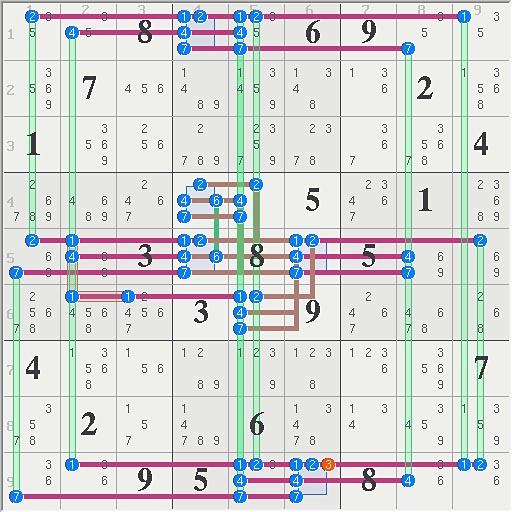FM, GN, and EM, Golden Nugget MorphedI have found one last piece of evidence in the comparison between the puzzles, GN, EM, and FM, and TR. Although both EM and FM have large, symmetric initial loops, FM's unusually difficult eliminations were probably due to the lack of bi-value sets in its initial loops, not because of the loop itself.
The final piece of evidence is the discovery of symmetrical loops in Golden Nugget. Although this
Golden Nugget Solution shows multi-layered structures, it had no symmetry. However, morphing the puzzle reveals initial loops that are very similar to FM. The structure below has 4 single-digit layers plus a very small layer 6 made of a single bi-value set, similar to Tungsten Rod. GN is very difficult but shows no abnormal initial difficulty like FM. In other words, all 4 puzzles have similar looped structures but FM is the only one without a bi-value set.
- Code: Select all
Golden Nugget Morph - Set Logic
E0[ 54 Nodes, Rank 1:
17 Sets = {1247r1 1247r5 1r6 1247r9 6c4 247b5}
18 Links = {27c1 14c2 1247c5 47c8 12c9 145n4 59n6 1b4}
--> (9n6) => r9c6<>3
Golden Nugget Morph - Pencil Grid
+-----------------------------------------------------------------------------+
| 35(2) 35(4) 8 | (1247) 35(1247 6 | 9 35(7) 35(1) |
| 3569 7 456 | 1489 13459 1348 | 136 2 13568 |
| 1 3569 256 | 2789 23579 2378 | 367 35678 4 |
+-----------------------------------------------------------------------------+
| 26789 4689 2467 | (2467) (247) 5 | 23467 1 23689 |
| 69(27) 69(14) 3 | (12467) 8 (1247) | 5 69(47) 69(2) |
| 25678 4568(1) 24567(1 | 3 (1247) 9 | 2467 4678 268 |
+-----------------------------------------------------------------------------+
| 4 13568 156 | 1289 1239 1238 | 1236 3569 7 |
| 3578 2 157 | 14789 6 13478 | 134 3459 1359 |
| 36(7) 36(1) 9 | 5 3(1247) 3(1247) | 8 36(4) 36(12) |
+-----------------------------------------------------------------------------+
Golden Nugget Morph - Logic Diagram
p452==================================================p562E=p542B=p442
p652 | | | Digit 2 Layer
| | | |
| p592==p512==========================p562E=p542B |
| | | | | |
p962========p952==============p992 | | | |
| | | | | |
| p142==p152====================p112 | | |
| | | | |
| | p454============================================p564F=p544C=p444
| | p654 | | | Digit 4 Layer
| | | | | |
| | | p524==p584==============p564F=p544C |
| | | | | | | |
| p144========p154====================p124 | | | |
| | | | | | |
p964===|==========p954==========================p984 | | |
| | | | |
| | p457======================================p567G=p547D=p447
| | p657 | | | Digit 7 Layer
| | | | | |
| | | p587==p517==p567G=p547D |
| | | | | | | |
| p147==============p157==========================p187 | | | |
| | | | | | |
p967===|================p957================================p917 | | |
| | | p546==p446 Digit 6 Layer
| | | |
| | p521A=p521A=====p561==p541
| | | | Digit 1 Layer
| | p651==p621H=p621H
| | | p631 |
| | | |
p961===|===================================p951==p991===p921
| | |
p141=================================p151=========p191
=====p256E \
| | Same node is in two (strong) sets, i.e., 2 sets overlap
=====p256E /
Golden Nugget Morph, first loop, grid image

No doubt, Strmckr will now be able to easily solve GN.

Strmckr wrote:Same loop is applicable to
Tungsten rod, and platiumn blonde.
Strmckr, in another thread wrote:i have been building 9-10+ er rated puzzles based on hidden linked fish (3x same arrangment patterns occuping the same cells.
It seems that we see some of the same structure inside of these monsters, you probably long before me. That is, single digit layers that communicate through common vertical cells. This makes sense because only the single digit layers can use the box constraints.



